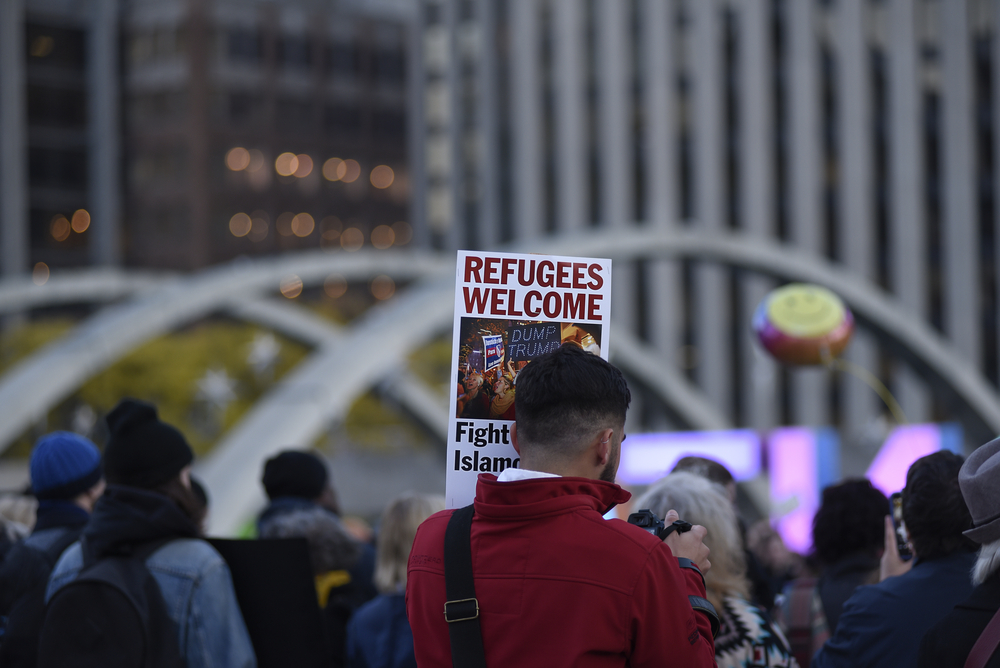In front of a small office in Toronto’s City Hall, a blue sign reads, “Newcomer Services.”
A table offers pamphlets and flyers, including a checklist of “Fourteen Things to Do in Your First Weeks in Canada” and an illustrated guide to “Dressing for Winter” for refugees arriving from warmer climates.
Settlement workers in the office provide newcomers help with language classes, health care and other new challenges.
But for newly arrived refugees, finding a safe place to live is the first priority.
And in Toronto, that’s increasingly difficult. With the city’s seven refugee-specific shelters at capacity, claimants are being shuffled into temporary hotel housing and homeless shelters. Despite the fact that Toronto has the largest homeless shelter system in Canada, the mainstream system is also reaching capacity.
When they first arrive in the city, refugee claimants can call the Red Cross First Contact program or the City of Toronto’s Central Intake Line to try and find housing.
Those agencies will refer them to shelters specifically for refugees, hotel-based temporary housing or homeless shelters.
The approach has been plagued with problems.
This summer, hundreds of refugees were housed in dormitories at Toronto colleges, then pushed out into temporary hotel housing, when students returned for the fall semester.
By late September, some 2,500 refugee claimants were living in Toronto’s shelters, according to Toronto’s Refugee Resettlement Program. And 15 to 20 new claimants were entering the system each day. In 2016, refugee claimants made up about 11 per cent of the total number of people in shelters in Toronto. By this June that had risen to 45 per cent.
Anne Woolger is founding director of Matthew House, a specialized shelter for refugees with four transition homes in Toronto. She says there simply aren’t enough specialized shelter beds for the number of refugee claimants and therefore more and more refugees have been shuffled into the city’s homeless shelter system, where workers are not able to provide the support they need. “In recent times there’s been a large overflow,” says Woolger.
Specialized shelters like Matthew House provide a range of supports to help refugees manage the transition to life in Canada. They offer orientation classes, help claimants prepare their applications for asylum and, once they move on to permanent housing, help them buy basic furnishings.
Woolger and others have been in talks with the city to come up with better solutions, including buying properties to use as refugee shelters rather than shelling out millions of dollars in hotel costs per year.
“Unfortunately, there’s a dilemma between dealing with the emergency at hand and long-term planning. And we kind of want to say, hold on, step back,” she says.
Increasing the number of refugee shelters to provide a transition between arrival and finding long-term housing would be a meaningful first step.
More shelters means refugees will have more resources and targeted support.
Though it’s difficult to forecast the number of refugee claimants in future years, UN Refugee Agency numbers indicate that global refugee populations have continued to grow for the sixth year in a row, with 25.4 million refugees and 68.5 million forcibly displaced people at the end of 2017. The global need for refugee resettlement isn’t changing anytime soon.
Refugees arriving in the country face many obstacles; knowing where they’re going to sleep during their first days and weeks doesn’t need to be one of them.
Beyond just the question of refugee shelters, finding permanent housing for refugees comes with a whole other set of obstacles. A lack of credit history, skeptical landlords who are hesitant to take on newcomers, an inability to pay upfront costs and difficulty navigating complicated paperwork in a second language can be huge barriers.
“To find any housing or any rental within the city for a newcomer refugee that has no financial credit established in the country is quite hard, because many of the landlords have that as a requirement,” says Lubna Shaban, a settlement counsellor from the Arab Community Centre of Toronto.
Settlement workers at the Newcomer Services desk at City Hall offer surprisingly conventional suggestions, like searching rental websites or kijiji.
But in a city where the vacancy rate in 2017 was one per cent and housing and rental costs remain sky high, searching for housing, even for non-refugee residents, can often be long and arduous.
Of the 6,000 refugee and asylum claimants who have gone through the city’s shelter system in the past two years, only about half are now settled in permanent housing.
Since 2016, Canada has experienced an influx of refugee claimants, many of whom arrived through irregular border crossings from the U.S.
But Woolger notes that the number of claimants, while high, is comparable to other years.
The biggest issue is the city’s lack of affordable housing overall.
“Fifteen years ago, they would come, they would stay in a shelter for maybe three or four weeks, they would find affordable housing here in Toronto, they would move out, and then other ones would come,” says Woolger. “But right now — and it’s a similar number coming — but they’re just not able to move out of the shelters within three or four weeks... so then the numbers are just piling up.”
To address the refugee housing issue the city will have to improve overall housing affordability and availability. More housing will need to be built, with a portion of that set aside as affordable housing. Expanding rent-geared-to income subsidies and “portable” housing benefits (benefits tied to an individual or family rather than a housing unit) could also help families afford housing.
For newcomers, who often have no family, friends or other support networks, these kinds of programs are especially important.
Settlement workers stress that finding long-term housing is essential to ensure newcomers are able to adjust effectively to their new environment. Once refugee newcomers have stable living arrangements, they can begin to establish deeper roots and begin their new lives in earnest.
“The number one checkpoint that we have on our list is the housing,” says Shaban. “Because once you have a stable address then you can locate the schools. Then you can start searching for a job... if you are a permanent resident, you can apply for your health card, and the Social Insurance Number and the rest.”
And for refugees, who have typically experienced considerable trauma in their country of origin and in their journey to Canada, an unstable living environment can serve as an additional emotional hardship.
Unfortunately for refugees arriving in Toronto, their search for a safe place to call home remains difficult.
Tomorrow: A personal look at the issue. Seila Rizvic writes about her family’s arrival as refugees in 1995, and the importance of housing to starting a life in a new country. ![]()
Read more: Rights + Justice, Housing

















Tyee Commenting Guidelines
Comments that violate guidelines risk being deleted, and violations may result in a temporary or permanent user ban. Maintain the spirit of good conversation to stay in the discussion.
*Please note The Tyee is not a forum for spreading misinformation about COVID-19, denying its existence or minimizing its risk to public health.
Do:
Do not: